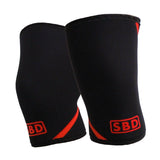Basic Strength Programme - Part 1: Squat
In today's blogpost, we will be talking about the very common and popular squat exercise.

The squat targets mainly muscles in your lower body such as the quadriceps, hamstrings, glutes, and also require the work of your core and abdominal muscles. In general, squats:
- promote overall muscle growth, especially in the lower body
- improve mobility of your lower body
- strengthen bones and joints (like any other weight training!)
How many times a week should I squat?
Squatting 3 times a week is ideal and necessary to improve your technique. Having someone around to observe that you are following the correct steps to squatting is also helpful. Give yourself at least 2 days of rest between each squat session.
How do I execute a good squat?
Set up and unracking of the barbell
1. Set the bar height at collar bone level
2. Go under the bar and position it across your shoulders. Grip the bar slightly outside of shoulder width.
Note: Your feet should be below the barbell. Keep your feet close (but not touching!), and your knees slightly bent.
3. Stand straight up and take 2 steps away from the rack.
Note: An ideal bar height ensures that when you stand up with the bar, it does not hit any part of the rack.
You also should not need to tip toe.
4. Position your feet just slightly wider than shoulder width.
Angle your toes about 45 degrees outwards.
Process
1. Inhale a mouthful of air into your belly. Keep that air in your belly!
2. Push your hips back (imagine sitting down on a chair) and lower yourself into a squat
3. Maintain balance over the middle of both feet.
4. Lower your hips until your thighs are parallel to the ground.
Finish
1. Exhale and stand back up to the starting position.
There you go - a repetition of the squat is complete!
In this video, SBD Singapore athlete Ashton demonstrates 1 repetition of the squat.
How do I find the starting weight to work with for squats?
1. Start by warming up with an empty bar. Follow the steps above as closely as possible. Do 8 repetitions with the empty bar.
2. Make small increments to the bar - add 2.5kg or 5kg a side each time. Do 5 repetitions for each warm up .
3. Increase the weight until you are unable to keep your squat form. You may feel yourself losing balance as your body-weight shifts to your heels or toes. You may have difficulty keeping your legs and body straight at ready position.
4. If the weight you are last able to execute a good squat is at 60kg, then 60kg will be the final weight to use for your working sets!
Remember, the purpose of warming up is to kick start your body's engine and increase blood flow throughout, not to tire you out before the actual working sets!
General Strength Template
Here's a sample program that is perfect for beginners, consisting of 2 squat sessions that you will repeat one after another.
In the example below, we use 60kg as a starting weight, but do replace this with the weight that you have found on your own.
| Session A | Session B | |
| Working Sets(S) X Reps(R) | 5S x 4R (60kg) | 90% of 60kg 3S x 6R (55kg) |
Repeat Sessions A and B every 2 days for 2 weeks. After which, increase the working weight for Session A by 2.5kg, and adjust accordingly for Session B. If you feel confident, you may also increase the working weight after 1 week!
At the end of the day, having proper technique is still key. Keep in mind to follow the instructions above as closely as possible in order to perform a safe and efficient squat.
Always start with an empty bar and do not rush to put on weights. Our emphasis on low repetitions ensure that you focus on building up good form, so put conscious effort into each step from the set up, to the process, and to finish. Learning how to properly perform a squat ensures its effectiveness and that any risks of injuries are reduced.
Use of equipment such as the belt and knee sleeves is not priority, but they enable you to lift safely by functioning as physical cues that remind your body how to brace without straining other muscles.
What SBD products can I use when squatting?
1. Knee Sleeves
Squatting helps to strengthen bones and improve joint health among many other benefits. Due to its load bearing nature, ensuring your knees stay healthy and pain-free in the process is also important. Click here to learn how SBD knee sleeves help to minimize injury risks by providing support and compression to your knees and joints during squats.
SBD Apparel Ambassador Clinton Lee demonstrates how to wear knee sleeves.
2. 13mm Lever Belt

Squatting requires core strength and stability, both of which can be achieved through having a strong lower back and abdominal muscles. These prevent unnecessary strain from being placed on your back, which can cause injury. Click here to learn how the belt serves as a cue for you to create abdominal pressure in order to perform an efficient squat.
SBD Apparel Ambassador Clinton Lee demonstrates the squat using the 13mm lever belt and knee sleeves.
Our next blog post talks about the bench press. Click here to read!
Looking for a professional to assist you in your progress? Reach out to us here at The Strength Yard SG.
